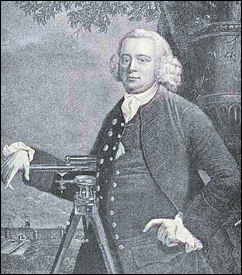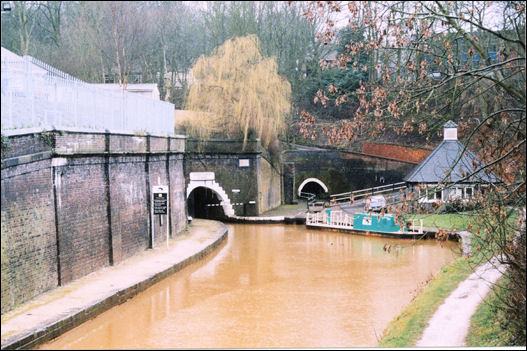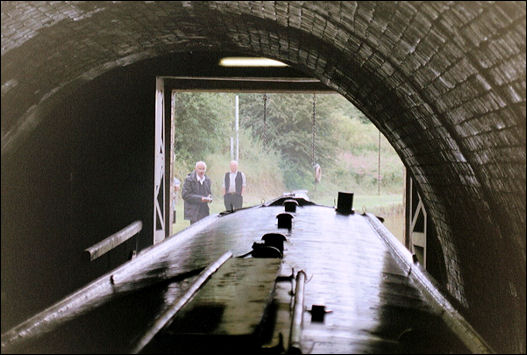|
James Brindley
- 'bad planning or pioneer of transport engineering?'
  
click the
"contents" button to get back to the main index & map
next: the boatman's walk to Kidsgrove
previous: Adams & Greengates, Tunstall
|
Historian Fred Hughes
writes....
Canal pioneer James Brindley might have been a brilliant engineer
but did he hack it as a planner? There’s no doubt that his Grand Trunk
Canal streamlined transportation like nothing since the Roman Roads. But
why didn’t he put a towpath through Harecastle Tunnel. Surely he must have
seen that taking the horses over the hill while boats were legged through
would result in troublesome delay. Was it bad planning or something else?
|
“The completed project which opened in 1777 after eleven years tunnelling,
certainly wasn’t designed high or wide enough for horses,” agrees
historian Steve Birks. “Brindley chose the option of propelling the boats
through the tunnel between Tunstall and Kidsgrove by casual labourers
lying supine and pushing along the roof and the sides with their legs. It
was hard work and it took three hours.”
See what I mean – bad planning.
“Well in fairness to Brindley the overall journeys to the ports of
Liverpool and Hull were speeded up spectacularly, and the breakage of
carriage was virtually eliminated,” contends Steve. “But the popularity
of the canal highlighted Harecastle’s logjam situation as hundreds of
boats queued to get through. Fifty years later Thomas Telford was
commissioned to build a second tunnel taking a quarter of the time that
Brindley took, mainly due to the advancement of engineering technology.”
So why didn’t Brindley foresee the bottleneck problems, he was after all
undertaking a superlative communications innovation that some were calling
the 8th wonder of the world even before it opened. Andy Perkin
is chairman of Potteries Heritage Society and a canal enthusiast. |

Portrait of James Brindley from Samuel Smiles,
Brindley is armed with his surveying equipment.
“You need to understand who James Brindley was and what he was doing at
the time,” says Andy. “He was a trained millwright who developed
exceptional skills in dealing with the control of water. Brindley was
miles ahead of anyone else in mine drainage and flooding. Employed by the
Duke of Bridgwater as a consultant engineer to work with the Duke’s own
engineer John Gilbert, they built a canal from Worsley to Stretford in
1761.
This caught the eye of Josiah Wedgwood who wanted Gilbert to construct a
canal for transportation of clay to the Potteries and ware to the ports.
With Gilbert he’d get Brindley. But Gilbert wasn’t available so Brindley
came alone. Straightaway unique problems were seen negotiating Harecastle
Hill at the bottom tip of the Pennines.
He couldn’t climb over the hill because he couldn’t get water up there.
Going round the valley through Bathpool would have added five miles to the
journey and more construction time involving intense soil mechanics. You
have to remember that Brindley was a mine and water engineer, so he stuck
to what he knew best. And of course he had to meet the budget of his
commissioners.”
|
But why no towpath, I wonder.
“Again we shouldn’t forget that an undertaking of such magnitude had
never been done before. Brindley was dealing in exacting innovative
measurement and he planned his tunnel to meet nine-foot diameter
dimensions in order to determine a seven-foot width of the boat.
Why – because of financial restrictions. The Mersey canals and existing
manufactured waterways were fourteen-foot wide and there’s no doubt that
had the resources been available Brindley would have gone for
fourteen-feet. The compromise seven-foot width on his canal at least
allowed for two boats to float side-by-side at their destination. The
financial constraints were mainly governed by the cost of getting
through Harecastle.
A towpath was never an option. Retrospectively it was like building the
original M1 with dual carriageways; nobody envisaged there’d be so much
traffic a decade later.”
How did Telford’s tunnel improve things?
“Well the commissioners had been taking advantage of the coal found during
the excavations of Brindley’s tunnel and cut a number of branches inside
purely to get the minerals out,” Andy explains.
“This made navigation more difficult. Telford sealed off these mine
warrens inside Brindley’s tunnel while he was constructing his new tunnel
which he designed to a diameter of thirteen-foot including a purpose-built
towpath throughout its length. There’s no doubt Telford’s tunnel was
state-of-the-art. But of course fifty years had passed and the Industrial
Revolution had introduced startling engineering advances. Nevertheless, in
his time everybody was in awe of Brindley.
He was an engineering genius whose outstanding ability literally exploded
people’s minds.” |

North entrance, the Telford tunnel to the left and Brindley's to the
right
These days the two tunnels sit side-by-side and the Telford Tunnel
is a very popular experience for pleasure boat tourists. David Fearn is
one of two British Waterways tunnel stewards on duty. He tells me that
since the increase of canal cruising some 6000 boats pass under Harecastle
each year.
“Regulations allow for a maximum convoy of eight boats each way,” says
59 year old David. “I’m based at the Kidsgrove end where I open the
tunnel gates in wireless conjunction with the gatekeeper at the other
end. It takes about forty-five minutes to pass through. Boats still
queue at each end, but people are patient.”
David and his wife Frances are retired. They live on the canal and travel
around entertaining with karaoke in pubs wherever they set anchor.
“Being a tunnel gatekeeper is a responsible job. But I tell you the only
trouble I get is keeping swans from swimming through,” David grins. “See
those two – Frances calls them Tip and Top – they’re here every day and
it’s a devil of a job to keep them out.”
Later I meet up with the Shaw family from Llandudno Junction. They’ve come
to Stoke on Trent especially to experience the journey through Telford’s
tunnel.
“It’s something we’ve wanted to do for ages,” declares parent Nigel Shaw.

Narrowboat leaving the south entrance of Tomas Telford's tunnel
And something I’ve always wanted to do is to follow the horse’s route over
the hill to meet my boat on the other side. The Shaw’s and I arrange to
put this to the test, they by water and me by road. I’ll tell you how we
went on next week.
next week: over Harecastle hill
  
click the
"contents" button to get back to the main index & map
next: the boatman's walk to Kidsgrove
previous: Adams & Greengates, Tunstall
|